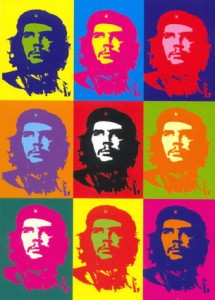 Che Guevara’s manual for guerrilla warfare was published a year after his bearded rebels marched triumphantly into Havana. Rebels across the world have thumbed its pages for tactics and strategies aimed at defeating their much more powerful foes. Unfortunately, it seems Che himself failed to abide by some of the text’s more logical insights in his disastrous (and mortal) mission to Bolivia. And yet, the Bolivia mission was par for the course of Che’s life; in the preface, he applauds his fallen comrade, Camilo Cienfuegos, for embodying Danton’s maxim that revolutionary movements require “audacity, audacity, and more audacity” (7).* The Cuban Revolution, he writes, proved that rebels could indeed defeat an army, that a small insurrectionary group (a guerrilla foco) can create and deepen revolutionary conditions, and that the “terrain” of armed struggle in underdeveloped parts of the Americas is fundamentally the countryside (14).
Che Guevara’s manual for guerrilla warfare was published a year after his bearded rebels marched triumphantly into Havana. Rebels across the world have thumbed its pages for tactics and strategies aimed at defeating their much more powerful foes. Unfortunately, it seems Che himself failed to abide by some of the text’s more logical insights in his disastrous (and mortal) mission to Bolivia. And yet, the Bolivia mission was par for the course of Che’s life; in the preface, he applauds his fallen comrade, Camilo Cienfuegos, for embodying Danton’s maxim that revolutionary movements require “audacity, audacity, and more audacity” (7).* The Cuban Revolution, he writes, proved that rebels could indeed defeat an army, that a small insurrectionary group (a guerrilla foco) can create and deepen revolutionary conditions, and that the “terrain” of armed struggle in underdeveloped parts of the Americas is fundamentally the countryside (14).
The text is clearly one of its times, and it has been roundly criticized for, among other things, its vanguardist pretensions: “The guerrilla band is an armed nucleus, the fighting vanguard of the people. It draws its great force from the people themselves” (16). Or as Cienfuegos put it: “El ejército es el pueblo uniformado” (165). The unabashed political chauvinism is not worth dwelling on since that aspect of his arguments are well known.
I was more interested by the comments that Che makes about territory and terrain, the environment and agrarian politics. For instance, in the expansion of guerrilla warfare across the country, Guevara writes:
This is an act similar to that of the beehive when at a given moment it releases a new queen, who goes to another region with a part of the swarm. The mother hive with the most notable guerrilla chief will stay in the less dangerous places, while the new columns will penetrate other enemy territories following the cycle already described. (18)
Territorial expansion through the creation of new focos takes on kind of lilypad, leapfrogging strategy—much like today’s global network of U.S. bases known as “Forward Operating Locations.” The success of guerrilla expansion for Che is of coursed strongly determined by its terrain of operation being places in the countryside that are sparsely populated, hard to access, provide a degree of physical mobility, and that have plenty of places to hide. “Since in these places the struggle of the people for reforms is aimed primarily and almost exclusively at changing the social form of landownership, the guerrilla fighter is above all an agrarian revolutionary” (17).
The desire for land is what Che sees as the economic base of the agrarian-based armed struggle. But what’s interesting is that he implies a certain set of internal relations between guerrilla tactics, radical agrarian politics, and geographical conditions. “All favorable conditions, all facilities of life normally induce men to settle; but for the guerrilla band the opposite is the case. The more facilities there are for social life, the more nomadic, the more uncertain the life of the guerrilla fighter” (44). Indeed, much of the book is more of a survivalist manual on how to make do amid the hellish conditions of everyday guerrilla life, punctuated though it might be by military combat.
*Some English translations are taken from the edition put out by the University of Nebraska
